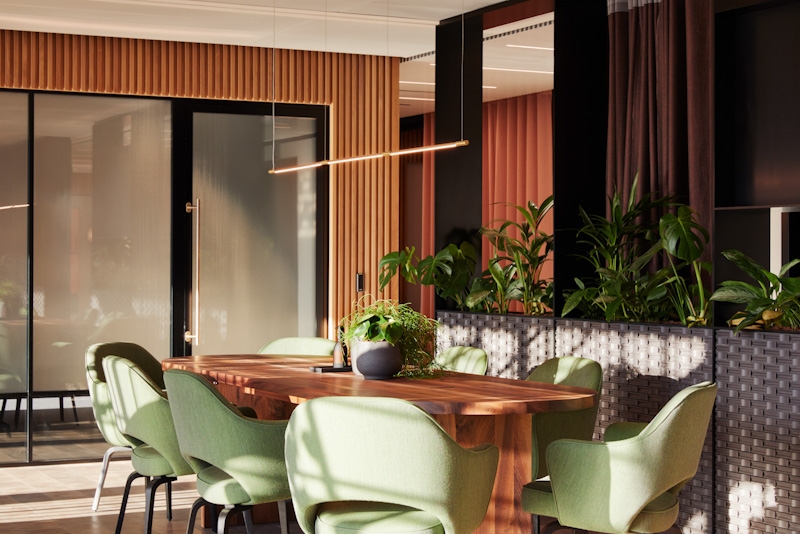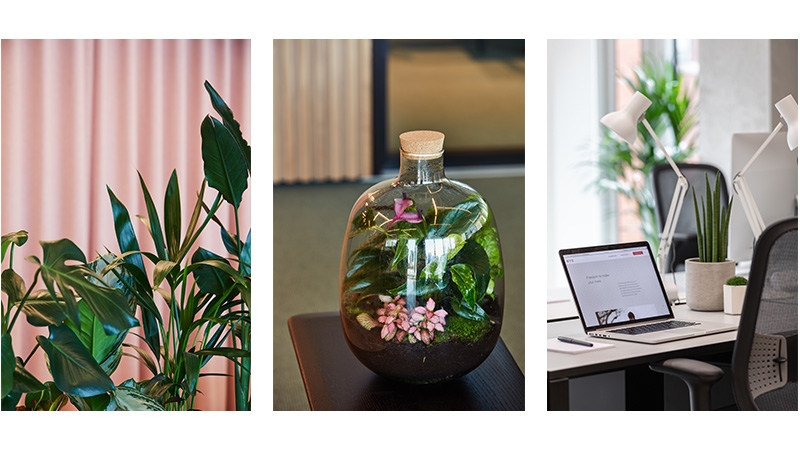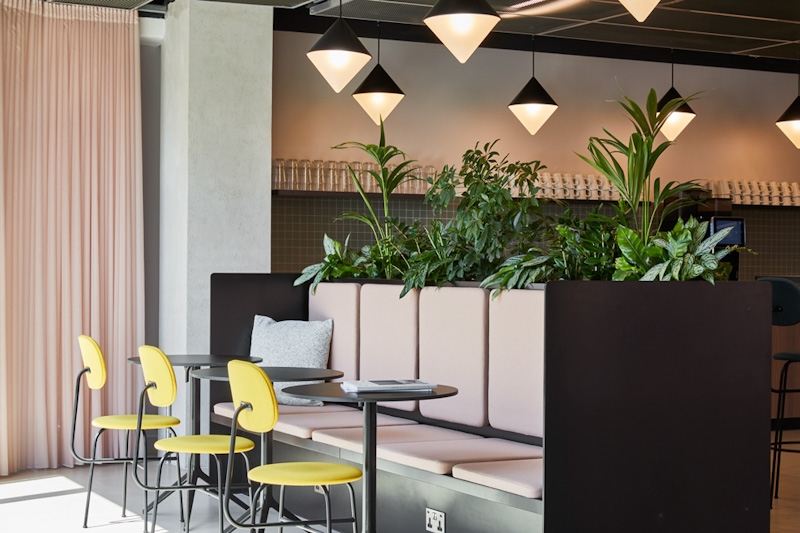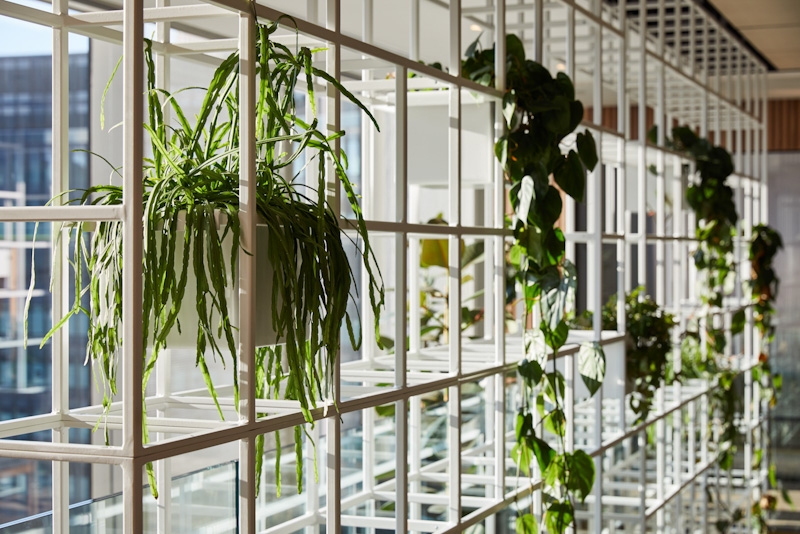It’s not just a fad – bringing plants into the office can create a calming, inspiring environment which improves employee satisfaction and focus. To find out how, we spoke to the experts behind the biophilic design at our Myo workspaces.
The benefits of bringing plants into office design
For many office workers, the pandemic gave us a chance to reconnect with nature.
Subsequently a spotlight has been shone on the benefits workplace biophilia (the human instinct to be close to nature) has on our mental health.
We all know that we can be happier, healthier, more productive and more creative if we regularly step away from the desk and get out in the great outdoors. But what about the great indoors? With current working patterns most of us spend most of our day inside. Part of the solution has to be to bring nature into the office.
Incorporating biophilia into the design of buildings is at the heart of Landsec’s ethos. Our flexible office spaces in London, Myo 123 Victoria Street and Myo Liverpool Street, are no exception and we worked with some of the most contemporary thinkers on office biophilia as part of the design process.
We spoke to two of those creatives: Rose Ray from biophilic design studio Ro Co and Megan Stinson from tailored plant providers, Exubia.

What is biophilic design?
And why is biophilia so popular in workplaces?
Exubia was founded in 1976, suggesting that biophilic design is nothing new, but Megan explains that it’s in recent years that the company has noticed an explosion of interest in biophilic design. She attributes this to a shift towards the prioritisation of wellbeing.
“There’s been a huge global shift towards a focus on mental health” Megan explains. “The mental health benefits of exposure to nature are prompting business owners to take a second look at how their offices are designed. This is coupled with a renewed interest in how a space feels. We’re now much more likely to be asked to help design a homely, co-working space, where plants naturally fit into the look and feel. Plants can be used to create natural divisions of space and to invoke a sense of tranquillity.”
For Ro Co, who were founded in 2014, the biophilia trend has shaped the evolution of the business ever since they started out on a little market stall in Hackney. Initially, Rose tells us she was surprised when she started receiving requests for office-installations. However, she soon realised that given the advantages for mental health and productivity, it made perfect sense.
Rose explains that whilst plants can add character and decoration to a space, biophilic design is about the integration of multiple natural elements to create a space that inspires and invokes calm. Everything from the temperature and smell of a room, to the inclusion of water-features, or different natural materials can play a role in creating the perfect biophilic interior. “We want to empower our customers to create their own little plant kingdoms indoors” Rose explained.
The transition to biophilic workplaces is also inspired by the broader drive towards sustainability. Megan explains: “clients ask for sustainable planters – they never used to do that!”

Is biophilic design playing a key role in attracting workers back to the office?
In the age of hybrid-working, it’s not enough for an office to just be functional.
It also needs to inspire and motivate. Companies now recognise that creating an environment that feels comfortable and well-considered adds to the overall employee experience.
Rose explains that “companies have realised that plants boost employee productivity and retention”. Surrounding office workers with plants and greenery will inevitably bring them closer to nature in a way that traditional city working won’t.
“People want a reason to go somewhere”, says Megan, “a feature blossom tree will always be more appealing than a random selection of wooden chairs”.
But biophilic benefits are not a one-way street. Megan tells us that there are incentives for business owners too: “Biophilic design allows a company to show their personality and values through the kind of plants chosen”.

Why was biophilic design so important to Myo?
Both Myo Liverpool Street and Myo 123 Victoria Street feature a range of carefully-chosen office plants.
For Megan at Exubia, the key was collaborating closely with Myo’s interior designers, Bluebottle. They were working to a strict brief to deliver Myo Liverpool Street – a bespoke space designed to optimise health and productivity.
Rose’s approach to Victoria Street was about creating a sense of purpose for workers. “When people feel responsible for a living thing, they are more likely to feel a connection to the space.” Rose also prioritised creating as much diversity as possible in this office by choosing different plant types with a variety of leaf shapes and colours. “We wanted to create impact and visual interest” she explained.
An important and often overlooked element of the design process was matching pots with plants, which was key to creating a visually coherent space. Pots also add a personal touch as each client has different preferences.
At Myo 123 Victoria Street, the use of plants and vegetation was a key component to help create the light, spacious and contemporary vision for the space.
The great thing about biophilic design is that it can literally grow with the space too. Some of Ro Co’s favourite client testimonials are about features that have evolved with the space, such as a creeping banister plant that gradually became immersed in the office. Workers even started taking cuttings to grow their own plants at home.

Which plants are most popular and why?
Smaller desk plants are still in demand but are no longer the “be-all and end-all” of biophilic design.
Currently, there’s huge demand for large and leafy plants. Megan suspects that after spending so long shut up indoors during the pandemic, a desktop plant is no longer satisfying our desire to be closer to nature.
A popular choice amongst Megan customers is the Fiddle-Leaf Fig, with its heart-shaped leaves and striking presence.
Trailing and hanging plants, which are equally visually impactful, are another firm favourite. The hanging plants at Myo Liverpool Street are a great example, pictured above.
What does the future of biophilic design look like?
Office plants are just one key element of biophilic design.
“People are going to want to take things even further”, Rose predicts. She suggests that design features like aromatherapy and sound will become more popular ways of creating a sense of calm in offices.
In whatever direction biophilic design evolves, one thing is clear – it is here to stay.
To learn more about biophilic design, check out Ro Co’s books. Or, you could read Exubia’s summary of the benefits of office plants.





